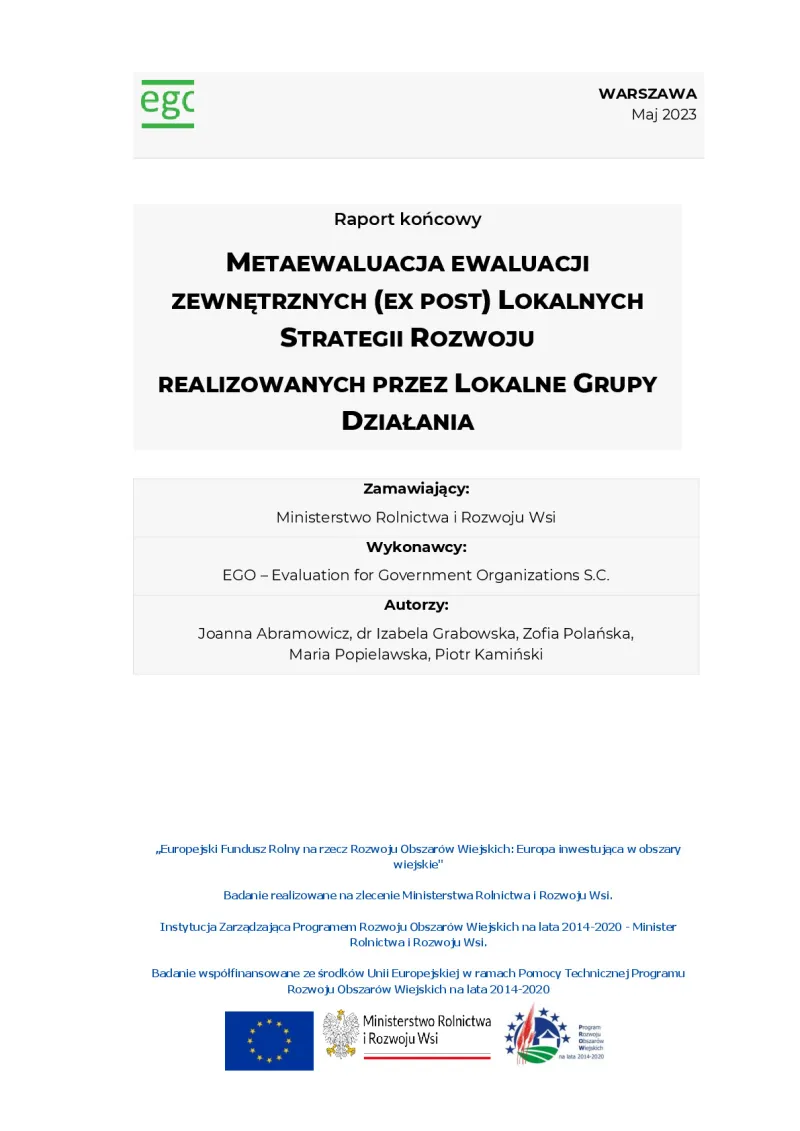Meta-evaluation of ex post evaluations of Local Development Strategies
- Evaluation
- Long-term Vision for Rural Areas
- Jobs, Growth and Equality in Rural Areas
- Agricultural Productivity
- Evaluation
- Ex Post Evaluation
This analysis examines 80 evaluation reports on the implementation of Local Development Strategies (LDS) across Poland.
- Poland
- Programming period: 2014-2022
- Cross-cutting impacts

This report assesses the outcomes achieved through the implementation of the LEADER approach, focusing on a meta-evaluation of ex post evaluations conducted by Local Action Groups (LAGs) across all regions of Poland. The primary objective is to evaluate the quality of these evaluations and identify best practices in implementing Local Development Strategies.
The evaluation has three primary goals; first, to consolidate and catalogue knowledge regarding the effects achieved at the programme level and within selected LAGs, particularly concerning LAG performance and the quality of evaluation studies. Second, it aims to aggregate, complete, and synthesise knowledge in specific thematic areas in response to the request for proposals. Lastly, the evaluation seeks to develop recommendations informed by the knowledge and experiences of both the contractor and external experts.
The methodological approach is based on desk research of evaluation reports and is supplemented by primary data collected through individual in-depth interviews and computer-assisted web interviews. The data sources include 80 evaluation reports as secondary data, while primary data were gathered from interviews and questionnaires. No specific indicators were used in the evaluation, as the report mainly focuses on textual analysis. The main elements assessed were the evaluation objectives and questions.
The report presents an analysis of the impact of the LEADER approach in various thematic areas, evaluates the performance of LAGs and assesses the quality of the evaluation studies conducted. It also identifies good practices in the implementation of ex post evaluations of Local Development Strategies.
The evaluation reports reveal that nearly all LAGs provided grants to businesses; however, the creation of processing incubators and the establishment of cooperation networks were less commonly addressed. Moreover, the reports did not analyse the impact of participation in the projects on entrepreneurs or individuals who started businesses, nor did they explore the sustainability of the project's effects.
The analysis of disadvantaged groups identified in the Local Development Strategies was verified using statistical data in most of the reports. However, approximately 25% of the reports relied on expert commentary rather than thorough statistical analysis. The support for these groups was generally regarded as an additional objective rather than a primary focus of the measures. Furthermore, the reports did not assess the effects of the interventions on disadvantaged groups who participated in the funded activities. Instead, the impact was measured using general economic and social indicators for the area, often without establishing a direct link to the interventions themselves.
Tourism and cultural heritage were commonly analysed in the majority of reports. Approximately 60% of the reports provided recommendations, although these were often general and focused on continuing support for these areas. Social capital was also discussed in all the reports. The complexity of demonstrating a direct connection between specific initiatives and the strengthening of social capital was highlighted.
The reports indicated that most projects implemented under Local Development Strategies, where an innovativeness criterion was applied, were considered innovative. Despite this, the evaluations pointed out that the level of innovation was generally low, with no supra-local innovations being identified.
The ex post evaluation of LAGs' functioning was rated highly in most reports. However, it is important to note that the surveys conducted with local residents were largely unrepresentative, which limited the credibility of the findings. Few reports attempted to quantify the added value of the LEADER approach, and many provided only brief responses to the research questions.
An analysis of the 80 evaluation reports revealed that the majority of them shared similar content, concentrating mainly on implementation aspects, presenting monitoring data and describing the socioeconomic conditions in the LAG areas. However, these evaluations often did not document the effects of the projects on the local population or explain how the observed effects were achieved.
The evaluation demonstrates that, while the LEADER approach has successfully facilitated grant distribution and contributed to specific areas such as tourism and social capital, the analysis in many reports lacks sufficient depth, particularly regarding project impacts and sustainability. The effects on disadvantaged groups and the level of innovation require a more detailed evaluation to capture the full impact of the LEADER approach on local development.
Author(s)
Joanna Abramowicz, dr Izabela Grabowska, Zofia Polańska, Maria Popielawska, Piotr Kamiński (EGO – Evaluation for Government Organizations S.C.)